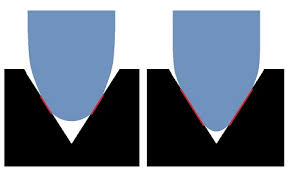The sound of stylus

The incredibly fine Nude Replicant stylus on Ortofon's A90 cartridge (magnified)
A stylus is the incredibly fine part that actually sits in the grooves of your record as it spins, and starts the process of bringing your music to life. Because the grooves on a record are VERY narrow, the design of your stylus makes a huge difference in how much information it can get out of those grooves. And the more information, the more “real” your music will sound when it comes out of your speakers.
Getting in shape
The grooves of a record are only 2.2 thousandths of an inch (0.0022") wide at the top, and shaped like a V, so a few millimetres difference here and there can make a huge impact on how your music comes out.
Because it sits quite wide in the groove, a spherical stylus is cheap to make and really easy to align (that is, get it sitting straight in the groove so that it reads both sides evenly – learn more about alignment here), you’ll commonly see them on DJ turntables and entry-level hi-fi turntables. The downside is that the broader tip means it can’t get into the groove as well, so a spherical stylus can leave out some of the finer details that make your music sound exciting.
 A spherical stylus (left) and an elliptical stylus
A spherical stylus (left) and an elliptical stylus
An elliptical stylus is a bit more tapered, allowing it to sit lower in the groove and reach the information that’s buried deeper. That means your music will sound more true-to-life, with a richer tone and more subtle details to enjoy. Elliptical styli are also quite versatile, genre-wise, so they’ll tackle whatever music you want to throw at them. This is the stylus you’ll find on the 2M Red and 2M Blue.
At the sharper end of the spectrum are Fine Line and Shibata styli, which come to an even more narrow tip than the elliptical. A Fine Line stylus sits roughly as wide as an elliptical stylus, but with a sharper tip that allows it to dig a bit deeper into the grooves again. That shape means you get a terrifically rich mid-range, with a natural-sounding roll-off on the high and low frequencies that analogue recording didn’t capture as well. You’ll find a Fine Line stylus on the 2M Bronze, which is why it has such a unique, vintage-flavoured sound. In contrast, the Shibata stylus (as found on the 2M Black) is more narrow and comes to an ever sharper tip than the Fine Line, so it can read almost every little detail in the groove with ease. Because of that, a Shibata stylus means you get sparkling high-frequencies and extended bass far beyond what other cartridges can manage.

An elliptical stylus (left) vs a Shibata stylus in the groove
The only real downside of Fine Line and Shibata styli is that they require much more precise alignment, as you’ll hear the difference much more readily if they’re sitting off-centre in the groove. If you’re using a stylus like these, use the Align It PRO to make sure everything is sitting exactly where it should be.
Shine bright like a diamond
The other thing that can affect the sound of your stylus is the material it’s made from. The very cheapest are made of metal, which is rough on your records and doesn’t sound very good either. Top-end styli like those on the 2M Bronze and 2M Black are completely made of diamond (also known as a “nude diamond stylus”), which is an extraordinary material for durability and detail. In the middle, you’ll find styli that have a diamond tip mounted to a piece of metal, called a tipped stylus. This is what the 2M Red uses, and it offers a nice balance between cost-effectiveness and versatile performance. In contrast, the 2M Blue has a nude diamond stylus, which allows vibrations to travel through it more efficiently, making for a more energetic, exciting sound.


















